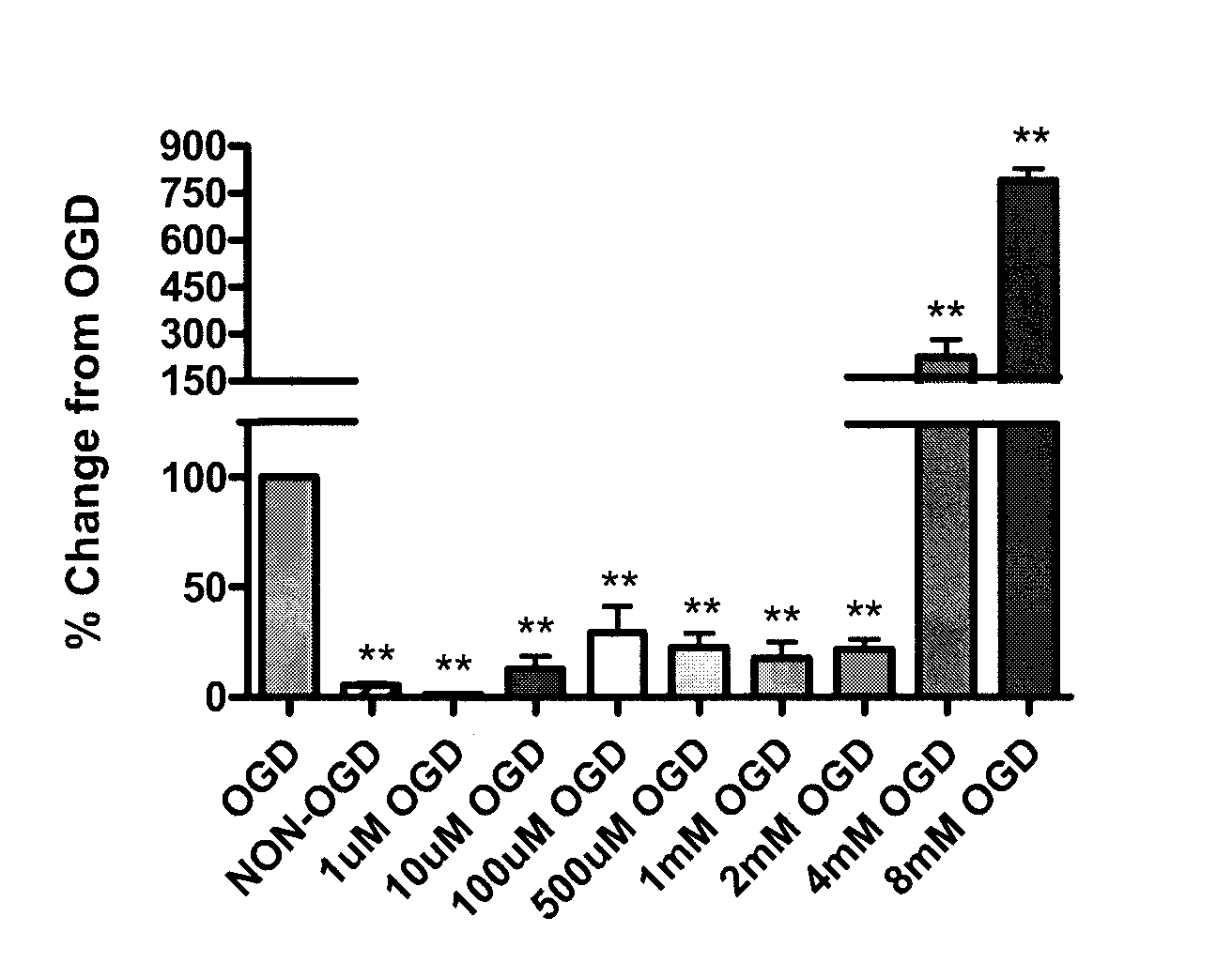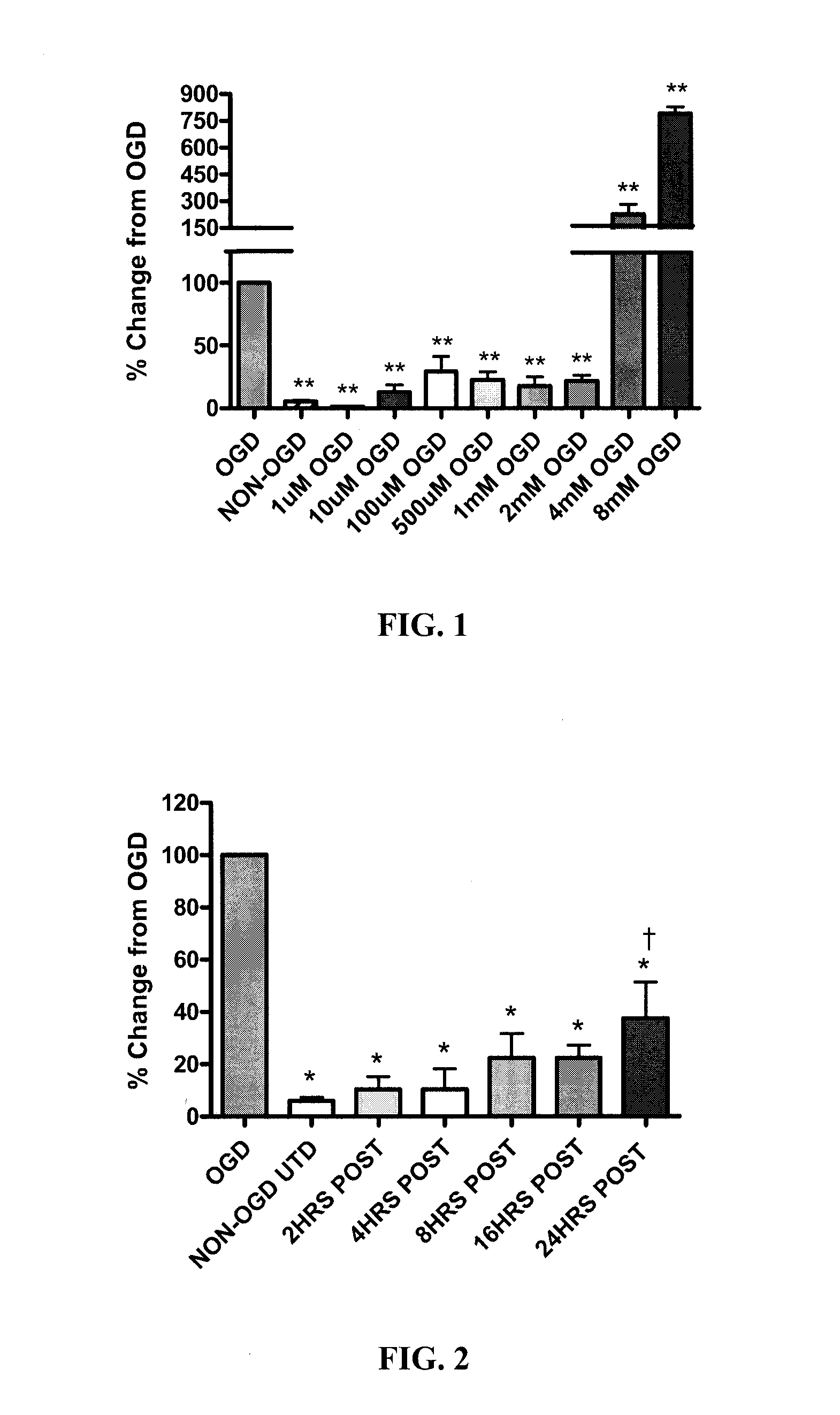Method of reducing brain cell damage or death
a brain cell and brain cell technology, applied in the direction of biocide, drug composition, nervous disorder, etc., can solve the problems of amphetamines not improving recovery, no preventative or neuroprotective therapy has proven to be effective in humans, and the performance of cognitive tasks is impaired, so as to reduce the occurrence of brain cell damage
- Summary
- Abstract
- Description
- Claims
- Application Information
AI Technical Summary
Benefits of technology
Problems solved by technology
Method used
Image
Examples
example 1
In Vitro Hippocampal Slice Studies
1.1 Materials and Methods
Hippocampal Slice Culture Preparation:
[0056]All experimental animal procedures were approved by the University Institutional Animal Care and Use Committee. Neonatal rats (Sprague-Dawley) at postnatal Day 7 (P7) were decapitated and the hippocampi dissected out under sterile conditions. 400 μm transverse hippocampal slices were prepared with a McIlwain tissue chopper and cultured on Millicell permeable membranes (0.4 μM pore size) in six well plates for 6 days at 37° C. in 5% CO2. Slices were maintained in a primary plating media for two days (50% DMEM (+) glucose, 25% HBSS (+) glucose, 25% heat inactivated horse serum, 5 mg / mL D-glucose (Sigma), 1 mM Glutamax, 1.5% PenStrep / Fungizone (Gibco), and 5 mL of 50X B27 (Gibco) supplement plus anti-oxidants that was changed every 24 hr. Next, the slices were placed in serum-free neurobasal medium (10 mL Neurobasal-A, 200 μL of 50× B27 supplement, 100 μL of 10× Fungizone, and 100 μL ...
example 2
In vivo Transient Cerebral Ischemia
2.1 Materials and Methods
Induction of Transient Cerebral Ischemia:
[0075]Gerbils were anesthetized with isoflurane and core-body temperature maintained at 37-38 C during surgery using a homeothennic blanket (Harvard Apparatus, South Natick, USA). A midline incision was made in the neck and the common carotid arteries were isolated and occluded for 5 min using 85-gm pressure aneurysm clips (ISCH; n=14). A second group of gerbils (SHAM; n=14) underwent the identical procedure except the carotid arteries were not clamped. The incision was sutured and animals received MAP (5 mg / kg; i.p) or equal volume of vehicle (saline; 0 mg) within 2 minutes of reperfusion. Animals were placed in a warmed cage, and observed for 30 minutes. Tylenol (8 mg / ml) was added to drinking water to provide postoperative analgesia.
Behavioral Testing and Histological Evaluation:
[0076]Each gerbil was tested 48 hrs following surgery in an open-field apparatus consisting of a metal ...
example 3
MCA Embolic Stroke Model in Adult Rats
3.1 Materials and Methods
[0081]Male Wistar rats at ages of 8-12 weeks, weighing 300-450 g were used in all experiments. A donor rat was anesthetized with 3.5% Isoflurane, and anesthesia was maintained with 1.0-1.5% Isoflurane in 70% N2O and 30% O2 using a face mask. Femoral arterial blood was withdrawn into 1 m of PE-50 tubing and retained in the tubing for 2 hours at room temperature, and subsequently retained for 22 h at 4° C. Four cm of the PE-50 tube containing rat clot was washed with saline for 5 minutes. A single rat clot (˜1 μl), was transferred to a modified PE-50 catheter with a 0.3 mm outer diameter filled with saline. Rats were then anesthetized with 3.5% Isoflurane, and anesthesia was maintained with 1.0-1.5% Isoflurane in 70% N2O and 30% O2 using a face mask throughout the surgical procedure. The Animal's muzzle was placed in the face mask 2 cm from the surgical site. Rectal temperature was maintained at 37±″0.5° C. throughout the ...
PUM
| Property | Measurement | Unit |
|---|---|---|
| Time | aaaaa | aaaaa |
| Time | aaaaa | aaaaa |
| Time | aaaaa | aaaaa |
Abstract
Description
Claims
Application Information
 Login to View More
Login to View More - R&D
- Intellectual Property
- Life Sciences
- Materials
- Tech Scout
- Unparalleled Data Quality
- Higher Quality Content
- 60% Fewer Hallucinations
Browse by: Latest US Patents, China's latest patents, Technical Efficacy Thesaurus, Application Domain, Technology Topic, Popular Technical Reports.
© 2025 PatSnap. All rights reserved.Legal|Privacy policy|Modern Slavery Act Transparency Statement|Sitemap|About US| Contact US: help@patsnap.com



